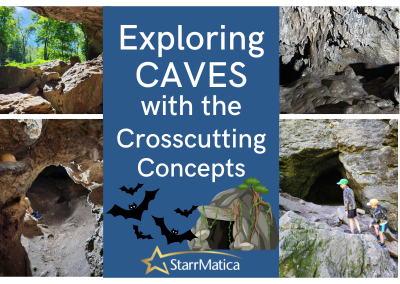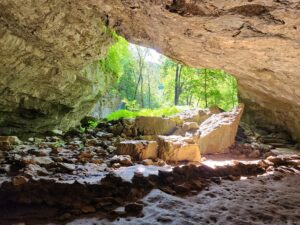 I visited the Maquoketa Caves, located just outside Maquoketa, Iowa, with my family yesterday as part of our effort to prolong the summer fun as the beginning of the school year looms – 6 days left in the countdown for us as I type this!
I visited the Maquoketa Caves, located just outside Maquoketa, Iowa, with my family yesterday as part of our effort to prolong the summer fun as the beginning of the school year looms – 6 days left in the countdown for us as I type this!
I hadn’t visited the caves since I was in high school, and I had forgotten just how impressive they are. In a state best known for gently rolling farmland – a visit to the caves seemed for us like being transported to another more remote, rocky, and forested part of the country.
As always, I viewed our visit with two distinct lenses: one as a Mom who sees her boys growing up too fast and wanting to enjoy every second with them and one as a science educator and advocate who sees phenomena and the crosscutting concepts everywhere I look.
I’d like to give you a look through that second science educator lens in the hopes that it may serve as a model for you as you think about helping your students to view the world around them like scientist. I also am excited to share some of our exploring because the caves are just so cool!
 Ever the nonfiction picture book enthusiast, on the drive to the caves, I read my boys the beautifully illustrated picture book: Caves by Nell Cross Beckerman. Not only did the book get my boys exited to “dare” to enter a dark cave, it also entertained us descriptions of unique and interesting caves around the world. While reading this book, I brought in the crosscutting concept of patterns by discussing what makes a cave – a cave. How are all of the caves similar? How are they different? You could also bring in concepts of stability and change and cause and effect by discussing how a cave forms and how long it might take. If I were strictly following best practices, we would have read the book on the way home because it did reveal some information – such as how caves are formed – that I would want my students to wonder for themselves if we were able to take a field trip to the caves.
Ever the nonfiction picture book enthusiast, on the drive to the caves, I read my boys the beautifully illustrated picture book: Caves by Nell Cross Beckerman. Not only did the book get my boys exited to “dare” to enter a dark cave, it also entertained us descriptions of unique and interesting caves around the world. While reading this book, I brought in the crosscutting concept of patterns by discussing what makes a cave – a cave. How are all of the caves similar? How are they different? You could also bring in concepts of stability and change and cause and effect by discussing how a cave forms and how long it might take. If I were strictly following best practices, we would have read the book on the way home because it did reveal some information – such as how caves are formed – that I would want my students to wonder for themselves if we were able to take a field trip to the caves.
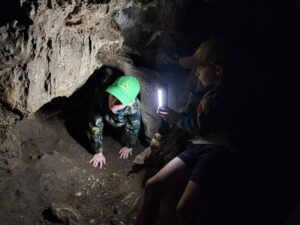 We spent several hours exploring the caves. The largest is big enough that everyone can enjoy walking through. And there are many smaller caves that everyone can have fun peeking inside while those more adventurous can commit to crawling through. Let’s just say that the boys and I ended up with soggy socks, bruised knees, muddy everything, and a plan to bring knee pads, and helmets with lights on our next visit.
We spent several hours exploring the caves. The largest is big enough that everyone can enjoy walking through. And there are many smaller caves that everyone can have fun peeking inside while those more adventurous can commit to crawling through. Let’s just say that the boys and I ended up with soggy socks, bruised knees, muddy everything, and a plan to bring knee pads, and helmets with lights on our next visit.
Here is a sampling of the phenomena we noticed while exploring and the different crosscutting concepts you could use to examine them with your students:
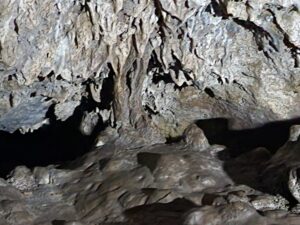 Cause and Effect: What caused this effect? What is the mechanism?
Cause and Effect: What caused this effect? What is the mechanism?
Patterns: Is there a pattern in the way these form throughout the caves we visit?
Scale, Proportion, and Quantity: How do these prove that there is something in water at a scale smaller than what we can see? How long did it take these to form? Why do you think that? How could you design an investigation to test your theory? (Science and Engineering Practice!)
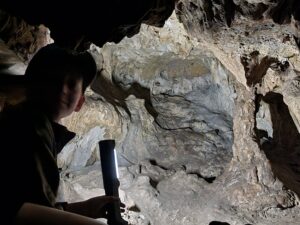 Cause and Effect: What caused this formation? What is the mechanism? Why do you think that?
Cause and Effect: What caused this formation? What is the mechanism? Why do you think that?
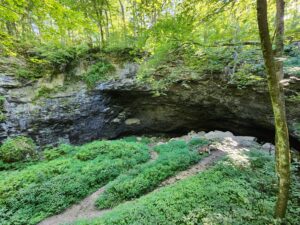 Cause and Effect: How did this cave form? What is the mechanism? What is your evidence?
Cause and Effect: How did this cave form? What is the mechanism? What is your evidence?
Scale, Proportion, and Quantity: How long do you think this cave took to form? What is your evidence?
Stability and Change: Is this cave stable or changing? How do you know? What could cause the cave to change suddenly?
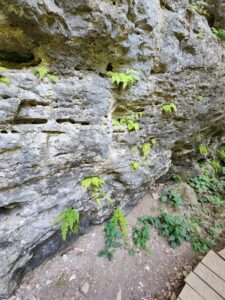 Cause and Effect: How are these plants able to grow out of the side of a rock?
Cause and Effect: How are these plants able to grow out of the side of a rock?
Stability and Change: How might these plants change the rock? Why do you think that?
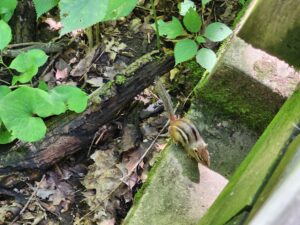 Energy and Matter: How does this chipmunk keep energy moving through the ecosystem?
Energy and Matter: How does this chipmunk keep energy moving through the ecosystem?
Systems and System Models: What are the parts of a cave and its surrounding ecosystem? How do those parts interact?
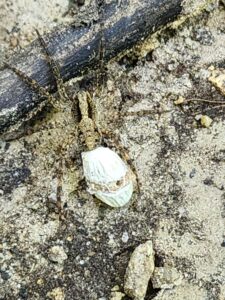 Structure and Function: How does the brown color of the spider help it to survive in this environment?
Structure and Function: How does the brown color of the spider help it to survive in this environment?
I could go on and on – even posting photos of the construction of the stairs we traversed, the man-made stones we stepped on, and the electric lighting in the largest cave to highlight how the crosscutting concepts can help us to understand designs in the field of engineering. Yet, I’ll pause here for now and hope that I’ve lit a spark in you to view your environment through a scientific lens. I can’t help myself – and it is my desire that one day your students won’t be able to help themselves either!
Don’t have a cave in your area to explore (and even if you do, it isn’t the most feasible field trip!)? You could always bring up some virtual cave tours to get your students noticing and wondering. Here are a few I found with a quick search:
https://www.nps.gov/grba/learn/photosmultimedia/virtual-cave-tour.htm
https://www.nationalgeographic.com/news-features/son-doong-cave/2/#s=pano37
https://www.tourdeforce360.com/carlsbad/
And just as a reminder: If there is narration, I would begin by turning it off along with the captions. Have your students notice and wonder FIRST! Don’t front load your lesson with a bunch of information. It shuts down their curiosity and ability to apply scientific lenses to what they are seeing.
PS – Watching several cave tours and noting similarities and differences would be a fun way to explore patterns!
PPS – There are so many connections to be made to NGSS standards with these photographs! A few that come to mind are:
K-ESS2-2 – Construct an argument supported by evidence for how plants and animals (including humans) can change the environment to meet their needs.
1-PS4-2 – Make observations to construct an evidence-based account that objects can be seen only when illuminated.
2-PS1-1 – Plan and conduct an investigation to describe and classify different kinds of materials by their observable properties.
4-ESS2-1 – Make observations and/or measurements to provide evidence of the effects of weathering or the rate of erosion by water, ice, wind, or vegetation.
5-ESS2-1 – Develop a model using an example to describe ways the geosphere, biosphere, hydrosphere, and/or atmosphere interact.
If you are looking for additional science texts, check out StarrMatica Texts: Science Your Way, our library of K-5 science informational texts that can be customized to meet specific Common Core ELA standards. Each 1st – 5th grade text has multiple reading levels so all of your students can read the same content independently.
Not a subscriber? Click here for a free trial to access our entire library of texts.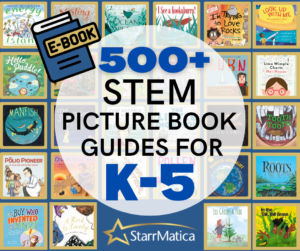
And if you are looking for additional picture books for your science classroom, check out the Perfect Picture Book Pairing Series that includes one-page guides with activities and discussion questions for hundreds of STEM-themed picture books aligned to every NGSS performance expectation!
CLICK HERE TO PREVIEW THE PERFECT PICTURE BOOK PAIRING EBOOKS

